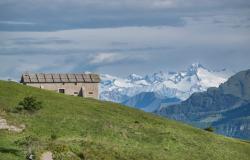Even if you perhaps don’t remember either the title or the author of this painting, you will certainly have seen it at least once. Because it is one of those images that are striking for their surreal streak: there is a well-dressed man, in dark clothes similar to an eighteenth-century institutional uniform, who glides elegantly on the ice, regardless of formal clothing. The painting is titled The Reverend Robert Walker skating on Duddingston Lakedates back more or less to 1790 and today is (almost) unanimously attributed to Sir Henry Raeburn, one of the most important Scottish artists. And the painting itself, exhibited for many years in the National Gallery of Scotland in Edinburgh, is among the best-known symbols of Scotlandbecause, although it was practically ignored until the 1950s, it later achieved such popularity that it was reproduced on postcards, stamps and, to leave the country, those who saw the TV series “White Collar” could see a reproduction of it in the study of one of the protagonists.
But what is a rigorously dressed reverend doing all alone, balancing on the surface of a frozen lake, skating with grace slightly tinged with humor, as the bland smile on his lips suggests? As always, it is worth starting with the life of the artist and the protagonist of the painting. Henry Raeburn, born in Edinburgh in 1756 and died here in 1823, had received a fair artistic education, had trained in a goldsmith’s workshop (in this work no one will miss the obsessive attention to detail) and painted numerous portraits during his career. But the life of Robert Walker, the reverend portrayed here, is much more interesting. Born on 30 April 1755 in Monkton, Ayrshire (yes, the man in the portrait is 35 years old), he had become minister of the Canongate Kirk in Edinburgh after spending much of his youth in Holland. And right here, in the canals of Rotterdam, he had learned to skate expertly, and in fact, in the portrait, the skates are “in Dutch style”, as the critics of the Scottish museum observe today, adamant in the attribution to Raeburn. Married with five children, the reverend was certainly not a boring exegete of sacred texts, on the contrary: he was a member of the prestigious Edinburgh Skating Club, one of the first figure skating clubs. And he practiced, in fact, on the frozen lake of the Duddingston neighborhood.
The painter chooses precisely this aspect, apparently contradictory to the minister’s position: a graceful figure of skating which features the body tilted forward, the arms crossed and the neck straight and in line with the headdress. A figure which, as the historian Andrew Graham-Dixon observed, allows one to travel long distances with minimal effort. And this is precisely the heart of the work: Reverend Walker embodies a graceful creature, elegant even in a sporting context, who moves firmly but without rigidity, fluid and confident yet maintaining a nuanced self-irony. The well-defined black silhouette of the minister carves out a precise autonomy in the landscape, which instead remains a delicate pink-grey cloud in the background, as if to indicate that the real protagonist here is man, not so much nature, and even the ice, a key element of the scene, fades into the background. To think that just a year earlier, in France, people like him could have found themselves on the guillotine. The landscape, however, is particular: it has the foggy hues of Joshua Reynoldsamong Raeburn’s masters, yet retains a menacing quality, as if anticipating Turner’s storms.
Above all, however, the black figure of the minister looms large, impassive in the cold that slightly reddens his face, engaged in the exercise of a balance which, in reality, he cultivated regularly, given that he was one of the most assiduous members of the club, meeting place of the Scottish bourgeoisie and numerous skate-loving intellectuals. And, if we try to delve into historical investigation, perhaps we discover that it was precisely this “worldly” nature of the Scottish cultural world to determine such a particular pictorial choice, or at least inspired it. Between the second half of the 18th and the beginning of the 19th century, Scotland was in fact at the center of a dynamic intellectual ferment that we can summarize with the expression Scottish Enlightenment, certainly with philosophical roots, but with important artistic, literary and even sporting branches. Voltaire himself observed, in 1762, that “today it is from Scotland that we take lessons in taste, from epic poetry to gardening”. Edinburgh at the time had just 40 thousand inhabitants, however its small size and above all the difference with the much more cosmopolitan and dense London of the time meant that ideas spread more widely within the city, embracing different social classes. Clubs, pubs, even these skating rinks, became places for discussion and the dissemination of ideas, as historian David Frost has observed. And so the poems of Robert Burns or the novels of Walter Scott could become a topic of conversation between one change of skates and another.
But not only that: the ideas of the philosopher David Hume, perhaps the most radical of the empiricists, also circulated easily, made accessible to all thanks to a profound literacy of society desired and promoted by the Presbyterian church. If we think that the same Encyclopedia Britannica was born in Scotland, precisely in Edinburgh, in 1768, we understand how culture, in that country and in that historical moment, was something to be spread, to be made understandable for everyone, something to be shared and verified with healthy pragmatism. Even in its most complex forms, we think of law or social sciences. And the Scottish Enlightenment was notable for its desire to understand human behavior: the empiricism of David Hume, but also the modern economic thought of another Scot, Adam Smiththe one who questioned the nature and causes of the wealth of nations, laying the foundations of macroeconomics.
We then understand how art also adapts to this particular, inquiring “feeling” of the human soul. Raeburn does not limit himself to conventional representations: it is easier to imagine a minister portrayed in contemplation in his study, but it takes courage to catch him skating. But a certain curiosity is also needed to go beyond representation: it doesn’t look for the scholar, it looks for the man who inhabits the scholar. The reverend who every day is called to embody a balance between theological research and humanity, between listening to others and meditation, warning and caress. Walker skates by challenging himself and his certainties first and foremost: isn’t this the meaning of his mission?





